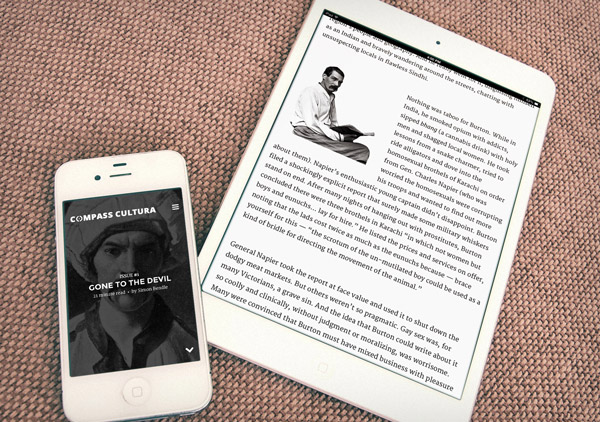Behind the scenes: Compass Cultura
I remember when I first read Craig Mod’s essay Subcompact Publishing, and felt something click. Here was a new way of thinking about digital magazines that did away with the print baggage to provide a simple, elegant reading experience that puts the reader first.
It’s a model that creative director Jeff Campagna has adopted for Compass Cultura, a new digital magazine that publishes three quality pieces of travel writing for $2 each issue. Issue one is a great read, so I contacted him to find out what he has planned for the project. The resulting interview is long, but totally fascinating for anyone interested in life at the coalface of independent digital publishing.

How did you come to start Compass Cultura?
Travelling and writing are the two most important things in my life. For the past few years, I’ve been spinning these two things together into work as a freelance journalist.
A little over a year ago, I had this idea for an online publication that celebrated in-depth travel journalism. The kind of journalism about places that I look for before travelling somewhere. I don’t want to know the 10 best places for buffalo wings in Buenos Aires or tips on how to bargain at Chatuchak Market in Bangkok. I want cultural exposés, geo-political investigations and touching human stories — and I want to read dynamic, original writing. Fun writing. Because reading should be fun. I don’t want to read dreary, butterless editorial or hard news.
I look for substance and style, and it wasn’t long before I realised these stories are extremely difficult to find. I’ve launched and sold a few general interest web projects over the past few years but they were traffic and advertisement oriented. If Compass Cultura was going to work at all, it had to be the opposite. It had to be content-over-clicks.
Did you ever consider it as a print project or was it always going to be digital?
Compass Cultura was born as a digitally-native product and, I’d imagine, it will stay that way. It may not always be presented as a subscription-based, responsive website however — one day, it may be an app or part of some digital reading framework yet to be invented — but I can’t see it ever coming out of a printer.
The whole beauty of digital publishing is the inherent freedom of it: being able to run as many words as you’d like. But in the printed world, page counts are fixed and word counts are limited. Online, it’s just a bit more scrolling. Sometimes this freedom is abused by longform articles that don’t truly need to be longform, but if an editor knows what they are doing, the web can be a great place for in-depth content.

You’ve got some great writing in there and a very low subscription price – are you able to pay writers?
We absolutely plan to pay writers. As a freelance journalist myself, this point is paramount. But, I made the decision to sidestep venture capital, pre-sales, crowd-funding and seed investors for a very important reason. Granted, it would have made the launch easier and required less programming work on my part and allowed us to pay writers out of the gates, but I truly believe that pre-funding a small publication like Compass Cultura is a dangerous game to play.
There are too many horror stories about start-up publications getting loads of venture capital at the beginning and then slowly realizing, once they need to depend more on revenue, that they built an unsustainable business. Venture capital can really spoil young publications in this way. I prefer revenue-backed growth to investment-backed growth. Thus, once we reach a critical mass with subscription revenue, we can begin assuredly paying writers.
The more subscribers we get, the more we can pay the writers. Until that happens, we’re publishing a mixture of donated original content, excerpts from books by indie travel authors and re-publishing features from other high-quality publications that aren’t widely available online. The Mudang’s Dance is an example of one of these features. It was originally published in print by Arc Magazine, the futurism imprint from New Scientist.
Do you have a number of subscribers you need to reach for Compass Cultura to become a sustainable business?
If Compass Cultura had 700-1,000 subscribers, we’d be in a comfortable position to pay writers and ourselves as well. It would also allow us to publish more than three articles each month, which is something we’ve considered doing down the line.
We don’t really plan to expand internally at all. Compass Cultura can be run by a pretty small crew and none of us plan on getting rich off of it. Our plan is to expand externally by offering our readers more content for the same subscription price, by being able to pay writers more and by being able to market and promote the publication on a wider scale.
How do you plan to reach more people and convince them to sign up?
It’s my opinion that so long as the writing on Compass Cultura speaks for itself and we treat our readers with respect, visitors will subscribe. I don’t imagine we’ll ever have millions of subscribers, though. And that’s not our goal. We’re a niche offering and we know it.
We don’t really want to ‘convince’ visitors to sign up. At $2/month, I think people will know right away if they are willing to support us or not. The last thing we want is to persuade visitors to subscribe and then lose their support a month or two later because we were unclear about what we were offering. We just have to find our audience by being active and engaged in the travel and journalism community and using, not abusing, social networking for awareness.

One of the reasons I don’t currently subscribe to any magazines on my phone is because I have Instapaper. Is there room for a magazine like Compass Cultura to make money when there’s so much free reading around?
You’re right. Right now at least, there’s plenty of free reading to be enjoyed online. But that will change. As the profitability of online advertising continues to sag, and the business itself continues to slow, many sites that people frequented for high-quality reading are turning to paywalls to cover the ad losses.
Slate is a perfect example of a high-quality outlet that was always free and people think it should stay free. And the overhead of the business is so high, the subscription price will also have to be high. As more and more major sites like Slate retreat behind partial or complete paywalls, publishers like Compass Cultura will not only be the norm, we’ll be specialists.
We launched with a subscription model so we already know we have to create a sustainable business model based on subscription revenue alone. For the past 15 years, the web has been a place where one goes to get free entertainment. Now, we’re in a shift. The web is becoming a place for users to find the entertainment they’re willing to pay for. The web is becoming less ‘landfill’ and more ‘marketplace’.
You’ve made a fantastically strong start with issue one – when’s issue two due? Can you say which places you’ll be covering?
Thank you very much. Issue two will be published on September 15th and each subsequent issue will be published on the second Monday of the month. We’re still lining up our content for the next couple of issues so I can’t be very specific about what will be in it. Rest assured: it’ll kick ass.
What do you hope to do with Compass Cultura in the future?
Well, in the very least, I hope to continue doing exactly what we are doing now: publishing great travel journalism for digitally-aware subscription prices. I’d love for Compass Cultura to eventually contribute to the professional success of the writers that it publishes — be it through access to better commissions and possible book deals or simply helping them build their fan base.
I’d like to explore the evolution of things like Kindle Singles, Apple Newsstand, Google Play and the ever-expanding App Store. I would also like it if Compass Cultura could stand proudly as a successful example of content-over-clicks for future digital publishers.





